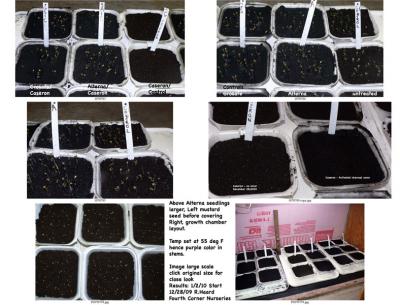Richard Haard, January 2010
Here is a simple screening test comparing herbicide inactivation by Biochar and Activated Charcoal. This test can be used to screen the relative adsorbtive capacity of your home made biochar by testing with an easily obtained herbicide, Caseron.
 .
.
Upper left treated set from right: activated charcoal powder, biochar granular, Caseron only
Upper right control set from right: activated charcoal, biochar, untreated.
Go to here for original image in high resolution (click original size) to view this up close
This test is with Caseron (dichlorobenil). Many other herbicides, pesticides are neutralized by activated charcoal. Use of activated charcoal is common accepted practice to clean up pesticide residues that result in poor performance via root development, germination, plant growth and vigor. Many herbicides such as Atrazine, Proamide, Amitrole and many others have either residual effect in soil or are transmitted in water. UC Riverside has nice tool for accessing leaching and runoff risk of chemicals as these here And as example here is profile for Atrazine, a widely used herbicide in corn production.
Results in plant performance then obtained with biochar that has adsorbtion properties similar to activated charcoal may be better explained by deactivation of toxins and/or natural/introduced inhibitors. Conversely farmers using herbicides as part of their normal production cycle may lose efficiency of their chemical applications if used coincidental with biochar.
Whether this property of biochar continues over time after active sites are filled up is not known to me and also whether these toxins are eventually degraded or released gradually in diluted form.

